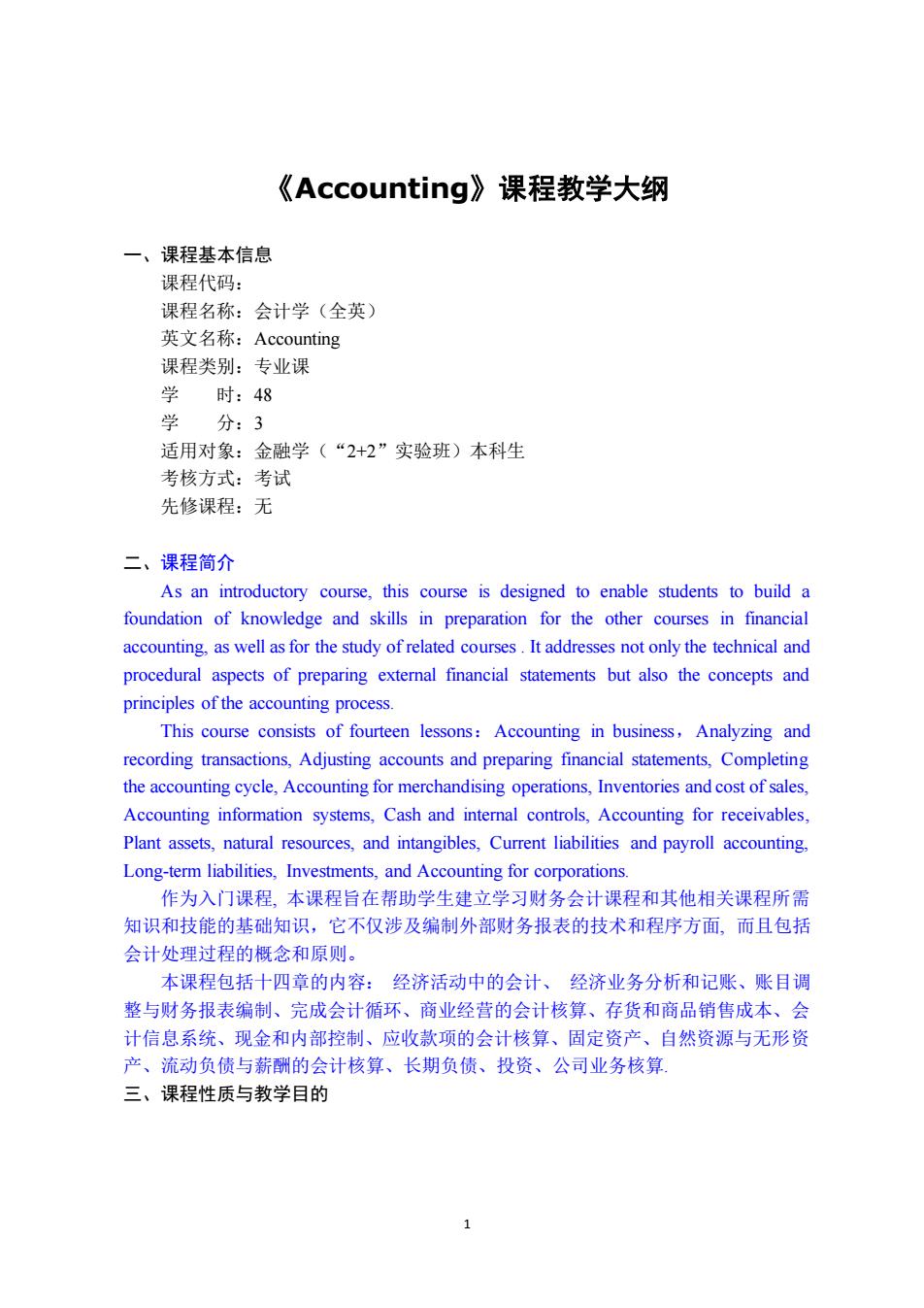
《Accounting》课程教学大纲 一、课程基本信息 课程代码: 课程名称:会计学(全英) 英文名称:Accounting 课程类别:专业课 时:48 学 分:3 适用对象:金融学(“2+2”实验班)本科生 考核方式:考试 先修课程:无 二、课程简介 As an introductory course,this course is designed to enable students to build a foundation of knowledge and skills in preparation for the other courses in financial accounting.as well as for the study of related courses.It addresses not only the technical and procedural aspects of preparing external financial statements but also the concepts and principles of the accounting process. This course consists of fourteen lessons:Accounting in business,Analyzing and recording transactions,Adjusting accounts and preparing financial statements,Completing the accounting cycle,Accounting for merchandising operations,Inventories and cost of sales, Accounting information systems,Cash and intemal controls,Accounting for receivables, Plant assets,natural resources,and intangibles,Current liabilities and payroll accounting. Long-term liabilities,Investments,and Accounting for corporations 作为入门课程,本课程旨在帮助学生建立学习财务会计课程和其他相关课程所需 知识和技能的基础知识,它不仅涉及编制外部财务报表的技术和程序方面,而且包括 会计处理过程的概念和原则。 本课程包括十四章的内容:经济活动中的会计、经济业务分析和记账、账目调 整与财务报表编制、完成会计循环、商业经营的会计核算、存货和商品销售成本、会 计信息系统、现金和内部控制、应收款项的会计核算、固定资产、自然资源与无形资 产、流动负债与薪酬的会计核算、长期负债、投资、公司业务核算。 三、课程性质与教学目的
1 《Accounting》课程教学大纲 一、课程基本信息 课程代码: 课程名称:会计学(全英) 英文名称:Accounting 课程类别:专业课 学 时:48 学 分:3 适用对象:金融学(“2+2”实验班)本科生 考核方式:考试 先修课程:无 二、课程简介 As an introductory course, this course is designed to enable students to build a foundation of knowledge and skills in preparation for the other courses in financial accounting, as well as for the study of related courses . It addresses not only the technical and procedural aspects of preparing external financial statements but also the concepts and principles of the accounting process. This course consists of fourteen lessons:Accounting in business,Analyzing and recording transactions, Adjusting accounts and preparing financial statements, Completing the accounting cycle, Accounting for merchandising operations, Inventories and cost of sales, Accounting information systems, Cash and internal controls, Accounting for receivables, Plant assets, natural resources, and intangibles, Current liabilities and payroll accounting, Long-term liabilities, Investments, and Accounting for corporations. 作为入门课程, 本课程旨在帮助学生建立学习财务会计课程和其他相关课程所需 知识和技能的基础知识,它不仅涉及编制外部财务报表的技术和程序方面, 而且包括 会计处理过程的概念和原则。 本课程包括十四章的内容: 经济活动中的会计、 经济业务分析和记账、账目调 整与财务报表编制、完成会计循环、商业经营的会计核算、存货和商品销售成本、会 计信息系统、现金和内部控制、应收款项的会计核算、固定资产、自然资源与无形资 产、流动负债与薪酬的会计核算、长期负债、投资、公司业务核算. 三、课程性质与教学目的
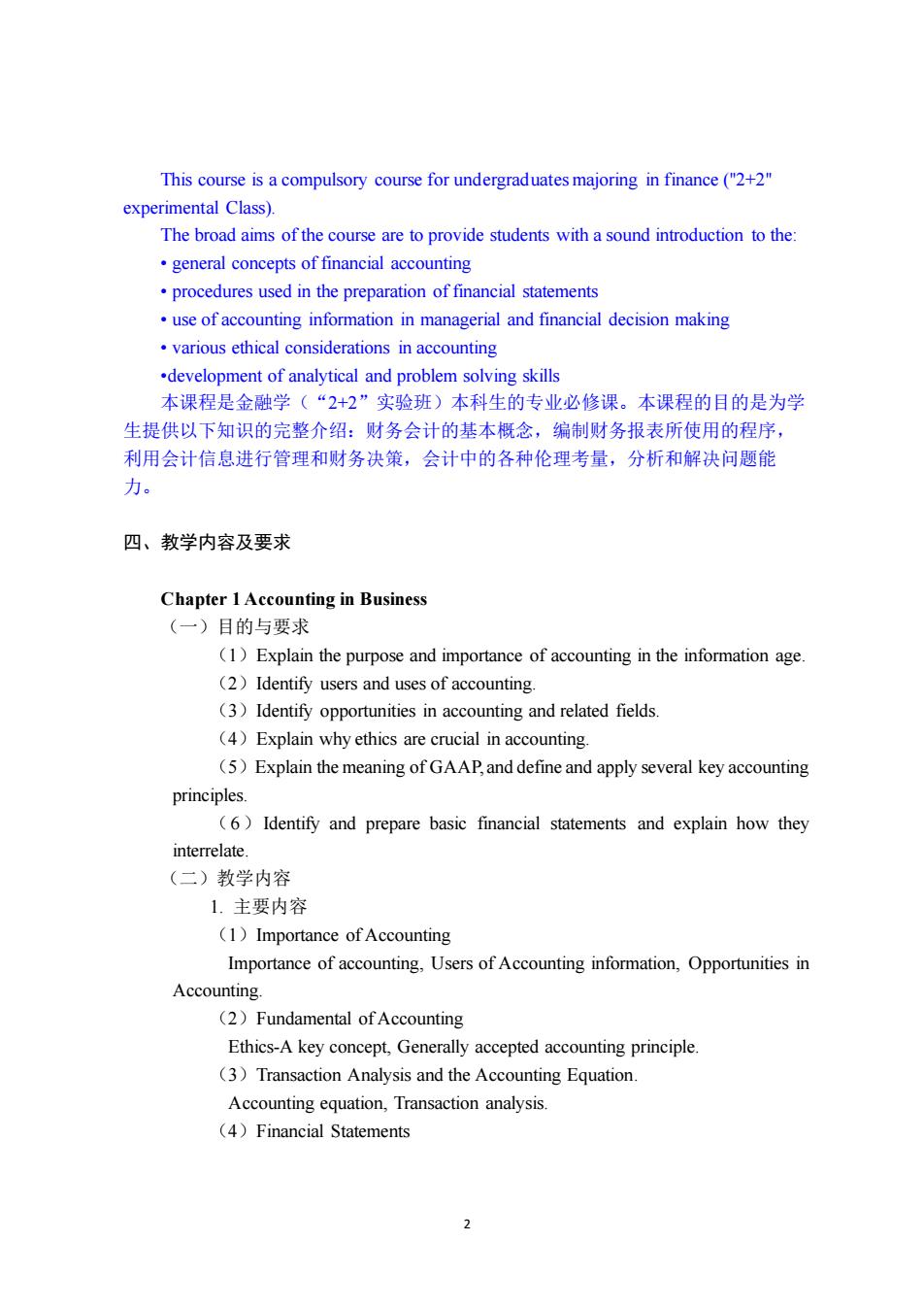
This course is a compulsory course for undergraduates majoring in finance("2+2" experimental Class). The broad aims of the course are to provide students with a sound introduction to the: .general concepts of financial accounting procedures used in the preparation of financial statements use of accounting information in managerial and financial decision making .various ethical considerations in accounting .development of analytical and problem solving skills 本课程是金融学(“2+2”实验班)本科生的专业必修课。本课程的目的是为学 生提供以下知识的完整介绍:财务会计的基本概念,编制财务报表所使用的程序, 利用会计信息进行管理和财务决策,会计中的各种伦理考量,分析和解决问题能 力。 四、教学内容及要求 Chapter 1 Accounting in Business (一)目的与要求 (1)Explain the purpose and importance of accounting in the information age. (2)Identify users and uses of accounting. (3)Identify opportunities in accounting and related fields. (4)Explain why ethics are crucial in accounting. (5)Explain the meaning of GAAP,and define and apply several key accounting principles. (6)Identify and prepare basic financial statements and explain how they interrelate (二)教学内容 1.主要内容 (1)Importance of Accounting Importance of accounting,Users of Accounting information,Opportunities in Accounting. (2)Fundamental ofAccounting Ethics-A key concept,Generally accepted accounting principle (3)Transaction Analysis and the Accounting Equation. Accounting equation,Transaction analysis (4)Financial Statements
2 This course is a compulsory course for undergraduates majoring in finance ("2+2" experimental Class). The broad aims of the course are to provide students with a sound introduction to the: • general concepts of financial accounting • procedures used in the preparation of financial statements • use of accounting information in managerial and financial decision making • various ethical considerations in accounting •development of analytical and problem solving skills 本课程是金融学(“2+2”实验班)本科生的专业必修课。本课程的目的是为学 生提供以下知识的完整介绍:财务会计的基本概念,编制财务报表所使用的程序, 利用会计信息进行管理和财务决策,会计中的各种伦理考量,分析和解决问题能 力。 四、教学内容及要求 Chapter 1 Accounting in Business (一)目的与要求 (1)Explain the purpose and importance of accounting in the information age. (2)Identify users and uses of accounting. (3)Identify opportunities in accounting and related fields. (4)Explain why ethics are crucial in accounting. (5)Explain the meaning of GAAP, and define and apply several key accounting principles. (6)Identify and prepare basic financial statements and explain how they interrelate. (二)教学内容 1. 主要内容 (1)Importance of Accounting Importance of accounting, Users of Accounting information, Opportunities in Accounting. (2)Fundamental of Accounting Ethics-A key concept, Generally accepted accounting principle. (3)Transaction Analysis and the Accounting Equation. Accounting equation, Transaction analysis. (4)Financial Statements
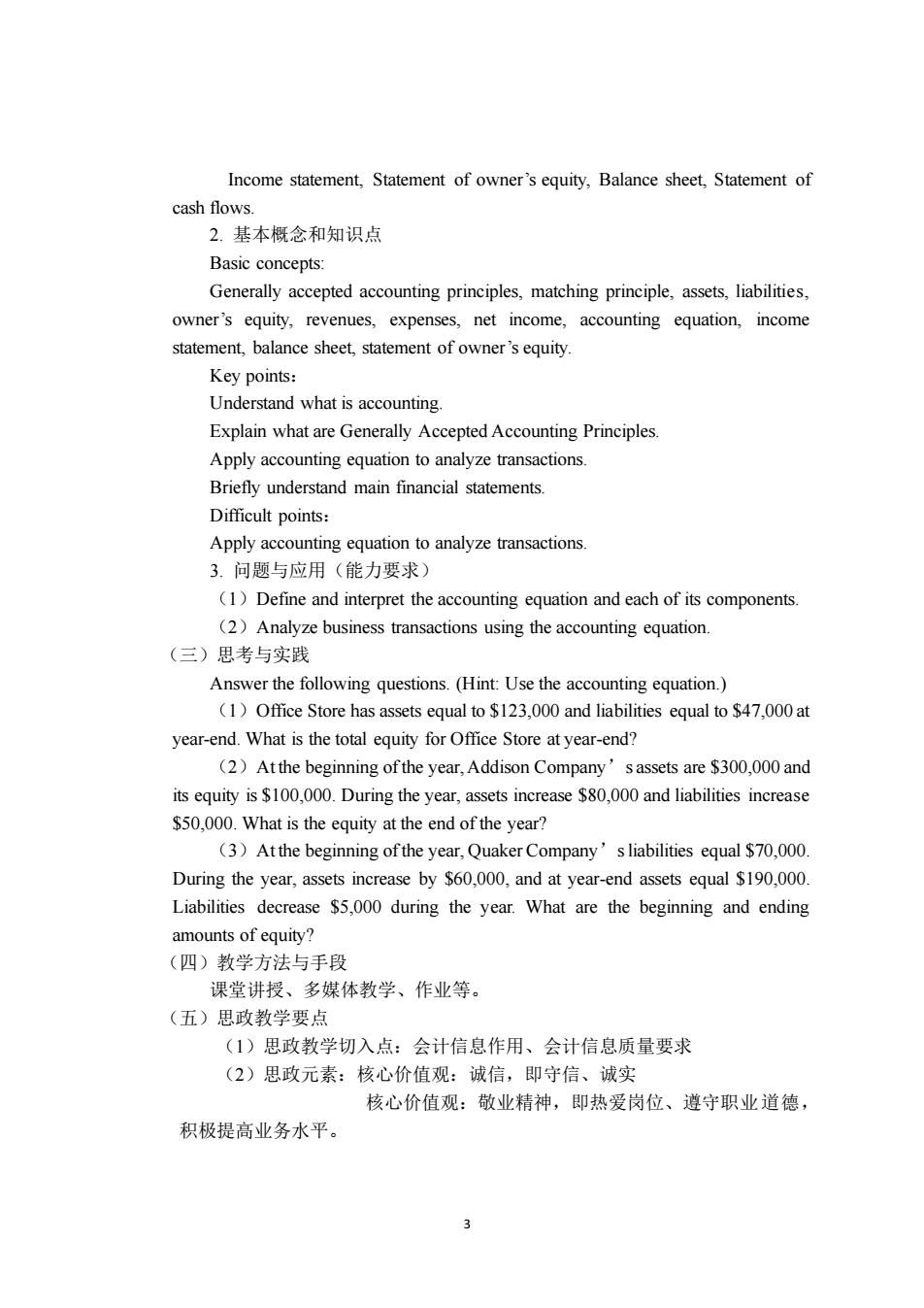
Income statement,Statement of owner's equity,Balance sheet,Statement of cash flows 2.基本概念和知识点 Basic concepts: Generally accepted accounting principles,matching principle,assets,liabilities, owner's equity,revenues,expenses,net income,accounting equation,income statement,balance sheet,statement of owner's equity. Key points: Understand what is accounting Explain what are Generally Accepted Accounting Principles. Apply accounting equation to analyze transactions. Briefly understand main financial statements. Difficult points: Apply accounting equation to analyze transactions. 3.问题与应用(能力要求) (1)Define and interpret the accounting equation and each of its components. (2Analyze business transactions using the accounting equation. (三)思考与实践 Answer the following questions.(Hint:Use the accounting equation. (1)Office Store has assets equal to $123,000 and liabilities equal to $47,000 at year-end.What is the total equity for Office Store at year-end? (2)Atthe beginning ofthe year,Addison Company'sassets are $300,000 and its equity is$100,000.During the year,assets increase$0,000 and liabilities increase $50.000.What is the equity at the end of the vear? (3Atthe beginning ofthe year,Quaker Company'sliabilities equal 70.000 During the year,assets increase by $60,000,and at year-end assets equal $190,000. Liabilities decrease $5,000 during the year.What are the beginning and ending amounts of equity? (四)教学方法与手段 课堂讲授、多媒体教学、作业等。 (五)思政教学要点 (1)思政教学切入点:会计信息作用、会计信息质量要求 (2)思政元素:核心价值观:诚信,即守信、诚实 核心价值观:敬业精神,即热爱岗位、遵守职业道德, 积极提高业务水平。 3
3 Income statement, Statement of owner’s equity, Balance sheet, Statement of cash flows. 2. 基本概念和知识点 Basic concepts: Generally accepted accounting principles, matching principle, assets, liabilities, owner’s equity, revenues, expenses, net income, accounting equation, income statement, balance sheet, statement of owner’s equity. Key points: Understand what is accounting. Explain what are Generally Accepted Accounting Principles. Apply accounting equation to analyze transactions. Briefly understand main financial statements. Difficult points: Apply accounting equation to analyze transactions. 3. 问题与应用(能力要求) (1)Define and interpret the accounting equation and each of its components. (2)Analyze business transactions using the accounting equation. (三)思考与实践 Answer the following questions. (Hint: Use the accounting equation.) (1)Office Store has assets equal to $123,000 and liabilities equal to $47,000 at year-end. What is the total equity for Office Store at year-end? (2)At the beginning of the year, Addison Company’s assets are $300,000 and its equity is $100,000. During the year, assets increase $80,000 and liabilities increase $50,000. What is the equity at the end of the year? (3)At the beginning of the year, Quaker Company’s liabilities equal $70,000. During the year, assets increase by $60,000, and at year-end assets equal $190,000. Liabilities decrease $5,000 during the year. What are the beginning and ending amounts of equity? (四)教学方法与手段 课堂讲授、多媒体教学、作业等。 (五)思政教学要点 (1)思政教学切入点:会计信息作用、会计信息质量要求 (2)思政元素:核心价值观:诚信,即守信、诚实 核心价值观:敬业精神,即热爱岗位、遵守职业道德, 积极提高业务水平
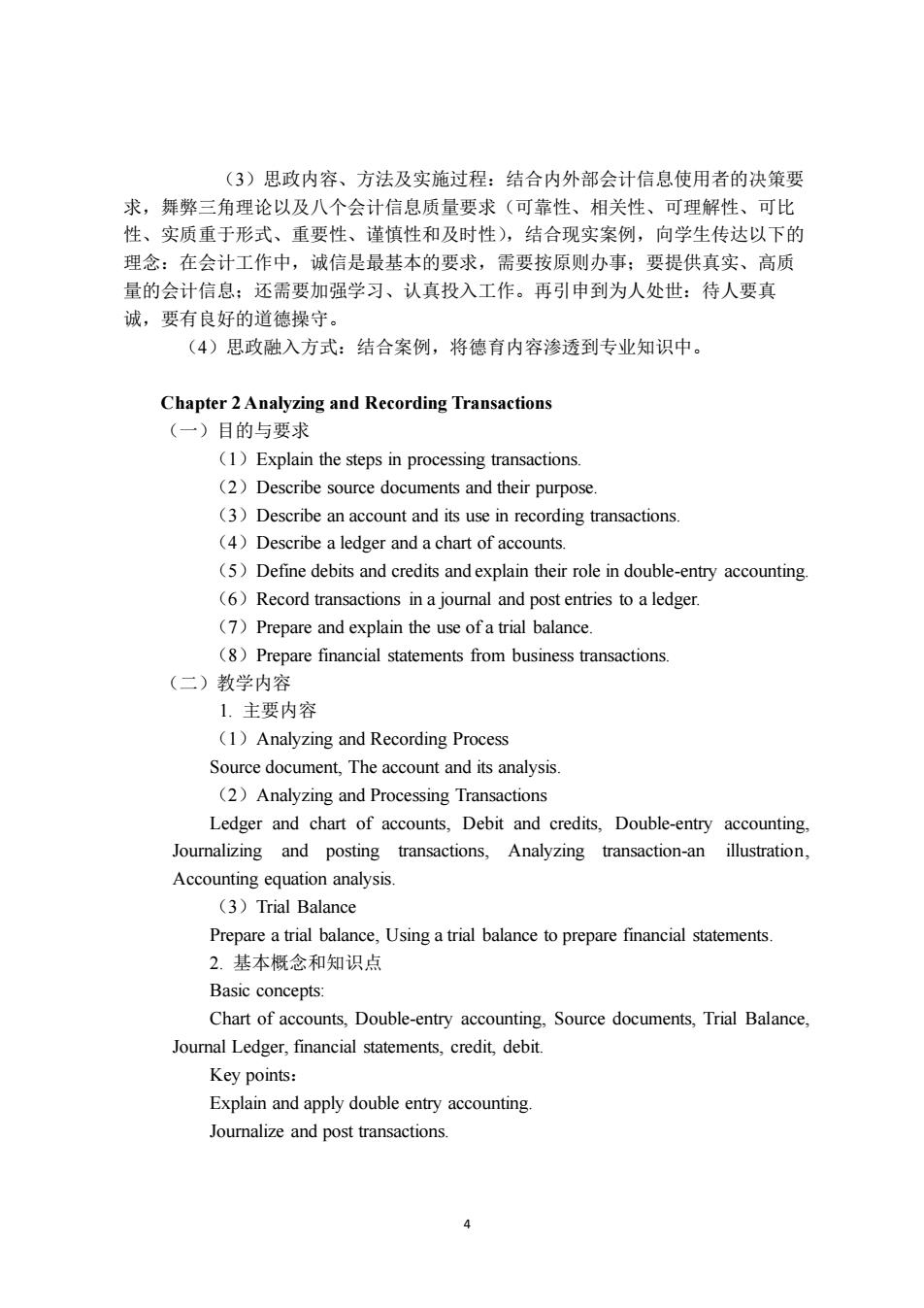
(3)思政内容、方法及实施过程:结合内外部会计信息使用者的决策要 求,舞弊三角理论以及八个会计信息质量要求(可靠性、相关性、可理解性、可比 性、实质重于形式、重要性、谨慎性和及时性),结合现实案例,向学生传达以下的 理念:在会计工作中,诚信是最基本的要求,需要按原则办事:要提供真实、高质 量的会计信息:还需要加强学习、认真投入工作。再引申到为人处世:待人要真 诚,要有良好的道德操守。 (4)思政融入方式:结合案例,将德育内容渗透到专业知识中。 Chapter 2 Analyzing and Recording Transactions (一)目的与要求 (1)Explain the steps in processing transactions (2)Describe source documents and their purpose. (3)Describe an account and its use in recording transactions (4)Describe a ledger and a chart of accounts. (5)Define debits and credits and explain their role in double-entry accounting (6)Record transactions in a journal and post entries to a ledger. (7)Prepare and explain the use of a trial balance. (8)Prepare financial statements from business transactions. (二)教学内容 1.主要内容 (1)Analyzing and Recording Process Source document.The account and its analysis. (2)Analyzing and Processing Transactions Ledger and chart of accounts,Debit and credits,Double-entry accounting Joumnalizing and posting transactions,Analyzing transaction-an illustration, Accounting equation analysis (3)Trial Balance Prepare a trial balance,Using a trial balance to prepare financial statements 2.基本概念和知识点 Basie concepts: Chart of accounts,Double-entry accounting,Source documents,Trial Balance, Joumal Ledger,financial statements,credit,debit. Key points: Explain and apply double entry accounting. Joumnalize and post transactions
4 (3)思政内容、方法及实施过程:结合内外部会计信息使用者的决策要 求,舞弊三角理论以及八个会计信息质量要求(可靠性、相关性、可理解性、可比 性、实质重于形式、重要性、谨慎性和及时性),结合现实案例,向学生传达以下的 理念:在会计工作中,诚信是最基本的要求,需要按原则办事;要提供真实、高质 量的会计信息;还需要加强学习、认真投入工作。再引申到为人处世:待人要真 诚,要有良好的道德操守。 (4)思政融入方式:结合案例,将德育内容渗透到专业知识中。 Chapter 2 Analyzing and Recording Transactions (一)目的与要求 (1)Explain the steps in processing transactions. (2)Describe source documents and their purpose. (3)Describe an account and its use in recording transactions. (4)Describe a ledger and a chart of accounts. (5)Define debits and credits and explain their role in double-entry accounting. (6)Record transactions in a journal and post entries to a ledger. (7)Prepare and explain the use of a trial balance. (8)Prepare financial statements from business transactions. (二)教学内容 1. 主要内容 (1)Analyzing and Recording Process Source document, The account and its analysis. (2)Analyzing and Processing Transactions Ledger and chart of accounts, Debit and credits, Double-entry accounting, Journalizing and posting transactions, Analyzing transaction-an illustration, Accounting equation analysis. (3)Trial Balance Prepare a trial balance, Using a trial balance to prepare financial statements. 2. 基本概念和知识点 Basic concepts: Chart of accounts, Double-entry accounting, Source documents, Trial Balance, Journal Ledger, financial statements, credit, debit. Key points: Explain and apply double entry accounting. Journalize and post transactions
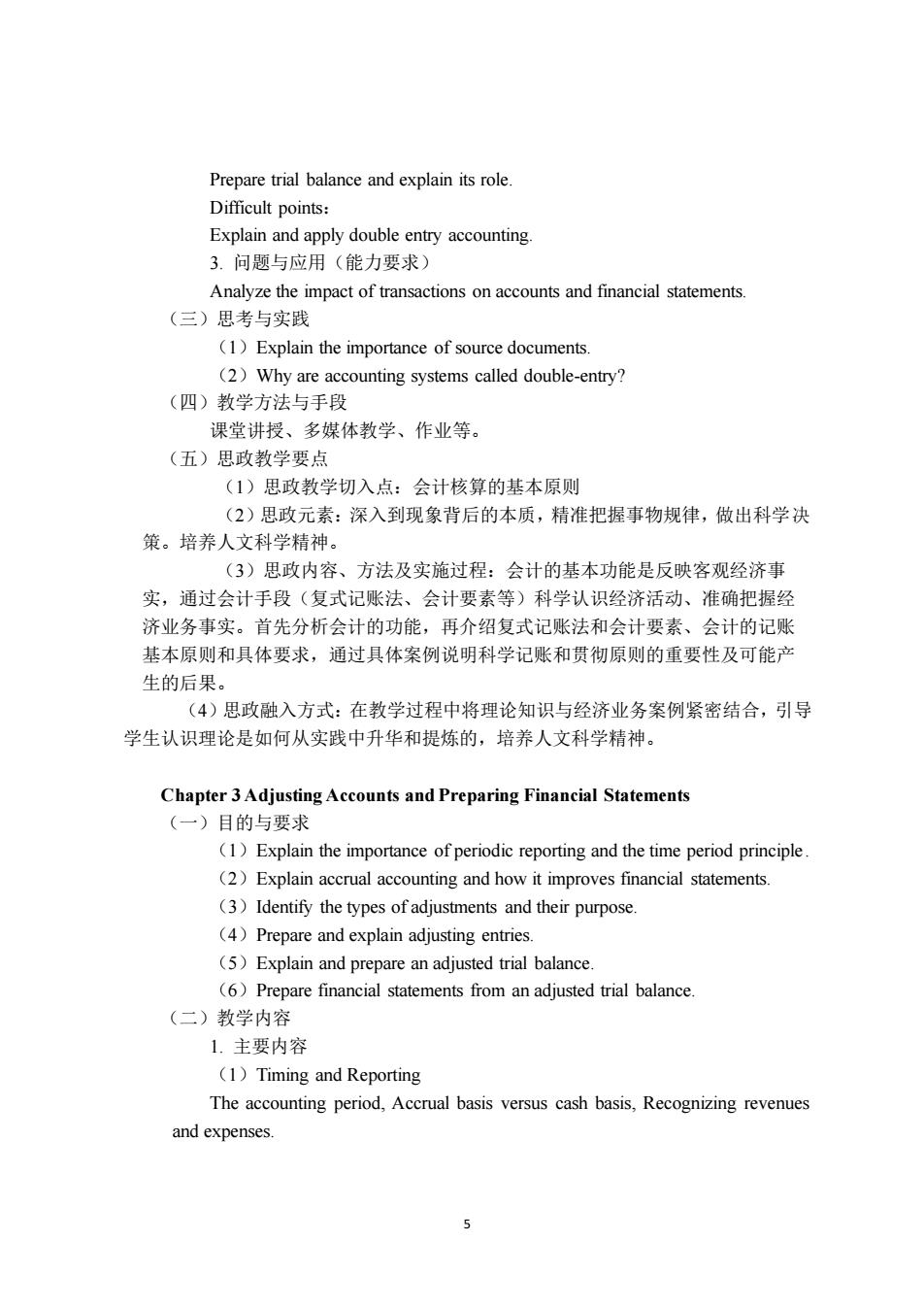
Prepare trial balance and explain its role. Difficult points: Explain and apply double entry accounting. 3.问题与应用(能力要求) Analyze the impact of transactions on accounts and financial statements (三)思考与实践 (1)Explain the importance of source documents (2)Why are accounting systems called double-entry? (四)教学方法与手段 课堂讲授、多媒体教学、作业等。 (五)思政教学要点 (1)思政教学切入点:会计核算的基本原则 (2)思政元素:深入到现象背后的本质,精准把握事物规律,做出科学决 策。培养人文科学精神。 (3)思政内容、方法及实施过程:会计的基本功能是反映客观经济事 实,通过会计手段(复式记账法、会计要素等)科学认识经济活动、准确把握经 济业务事实。首先分析会计的功能,再介绍复式记账法和会计要素、会计的记账 基本原则和具体要求,通过具体案例说明科学记账和贯彻原则的重要性及可能产 生的后果。 (4)思政融入方式:在教学过程中将理论知识与经济业务案例紧密结合,引导 学生认识理论是如何从实践中升华和提炼的,培养人文科学精神。 Chapter 3Adjusting Accounts and Preparing Financial Statements (一)目的与要求 (1Explain the importance of periodic reporting and the time period principle (2)Explain accrual accounting and how it improves financial statements. (3)Identify the types ofadjustments and their purpose (4)Prepare and explain adjusting entries. (5)Explain and prepare an adjusted trial balance. (6)Prepare financial statements from an adjusted trial balance. (二)教学内容 1主要内容 (1)Timing and Reporting The accounting period,Accrual basis versus cash basis,Recognizing revenues and expenses. 5
5 Prepare trial balance and explain its role. Difficult points: Explain and apply double entry accounting. 3. 问题与应用(能力要求) Analyze the impact of transactions on accounts and financial statements. (三)思考与实践 (1)Explain the importance of source documents. (2)Why are accounting systems called double-entry? (四)教学方法与手段 课堂讲授、多媒体教学、作业等。 (五)思政教学要点 (1)思政教学切入点:会计核算的基本原则 (2)思政元素:深入到现象背后的本质,精准把握事物规律,做出科学决 策。培养人文科学精神。 (3)思政内容、方法及实施过程:会计的基本功能是反映客观经济事 实,通过会计手段(复式记账法、会计要素等)科学认识经济活动、准确把握经 济业务事实。首先分析会计的功能,再介绍复式记账法和会计要素、会计的记账 基本原则和具体要求,通过具体案例说明科学记账和贯彻原则的重要性及可能产 生的后果。 (4)思政融入方式:在教学过程中将理论知识与经济业务案例紧密结合,引导 学生认识理论是如何从实践中升华和提炼的,培养人文科学精神。 Chapter 3 Adjusting Accounts and Preparing Financial Statements (一)目的与要求 (1)Explain the importance of periodic reporting and the time period principle. (2)Explain accrual accounting and how it improves financial statements. (3)Identify the types of adjustments and their purpose. (4)Prepare and explain adjusting entries. (5)Explain and prepare an adjusted trial balance. (6)Prepare financial statements from an adjusted trial balance. (二)教学内容 1. 主要内容 (1)Timing and Reporting The accounting period, Accrual basis versus cash basis, Recognizing revenues and expenses
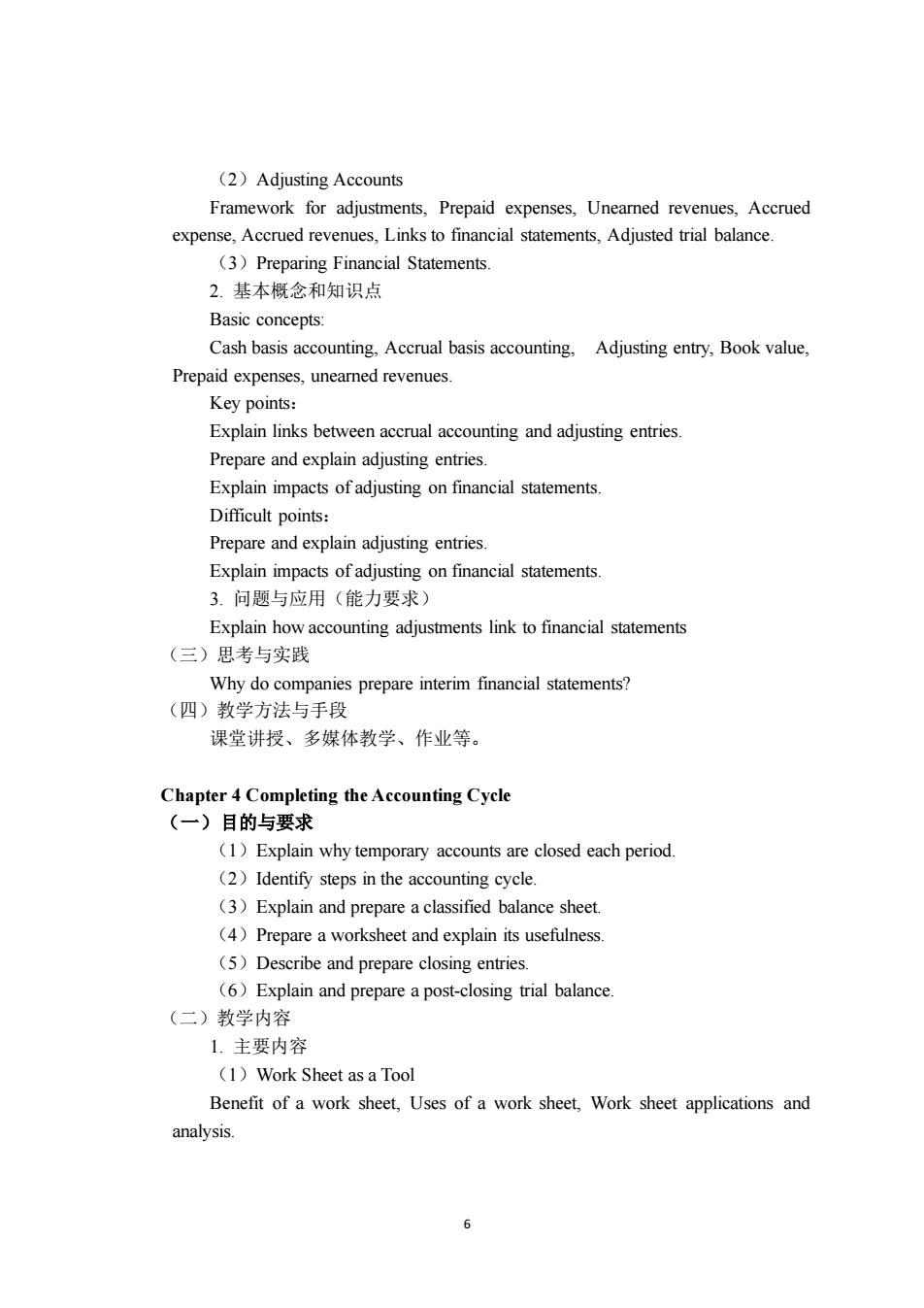
(2)Adjusting Accounts Framework for adjustments,Prepaid expenses,Unearned revenues,Accrued expense,Accrued revenues,Links to financial statements,Adjusted trial balance. (3)Preparing Financial Statements. 2.基本概念和知识点 Basic concepts: Cash basis accounting.Accrual basis accounting.Adjusting entry.Book value Prepaid expenses,unearned revenues. Key points: Explain links between accrual accounting and adjusting entries Prepare and explain adjusting entries. Explain impacts of adjusting on financial statements Difficult points: Prepare and explain adjusting entries. Explain impacts of adjusting on financial statements 3.问题与应用(能力要求) Explain how accounting adjustments link to financial statement (三)思考与实践 Why do companies prepare interim financial statements? (四)教学方法与手段 课堂讲授、多媒体教学、作业等 Chapter 4 Completing the Accounting Cycle (一)目的与要求 (1)Explain why temporary accounts are closed each period (2)Identify steps in the accounting cycle. (3)Explain and prepare aclassified balance sheet. (4)Prepare a worksheet and explain its usefulness. (5)Describe and prepare closing entries. (6)Explain and prepare a post-closing trial balance (二)教学内容 1.主要内容 (1)Work Sheet as a Tool Benefit of a work sheet,Uses of a work sheet,Work sheet applications and analysis
6 (2)Adjusting Accounts Framework for adjustments, Prepaid expenses, Unearned revenues, Accrued expense, Accrued revenues, Links to financial statements, Adjusted trial balance. (3)Preparing Financial Statements. 2. 基本概念和知识点 Basic concepts: Cash basis accounting, Accrual basis accounting, Adjusting entry, Book value, Prepaid expenses, unearned revenues. Key points: Explain links between accrual accounting and adjusting entries. Prepare and explain adjusting entries. Explain impacts of adjusting on financial statements. Difficult points: Prepare and explain adjusting entries. Explain impacts of adjusting on financial statements. 3. 问题与应用(能力要求) Explain how accounting adjustments link to financial statements (三)思考与实践 Why do companies prepare interim financial statements? (四)教学方法与手段 课堂讲授、多媒体教学、作业等。 Chapter 4 Completing the Accounting Cycle (一)目的与要求 (1)Explain why temporary accounts are closed each period. (2)Identify steps in the accounting cycle. (3)Explain and prepare a classified balance sheet. (4)Prepare a worksheet and explain its usefulness. (5)Describe and prepare closing entries. (6)Explain and prepare a post-closing trial balance. (二)教学内容 1. 主要内容 (1)Work Sheet as a Tool Benefit of a work sheet, Uses of a work sheet, Work sheet applications and analysis
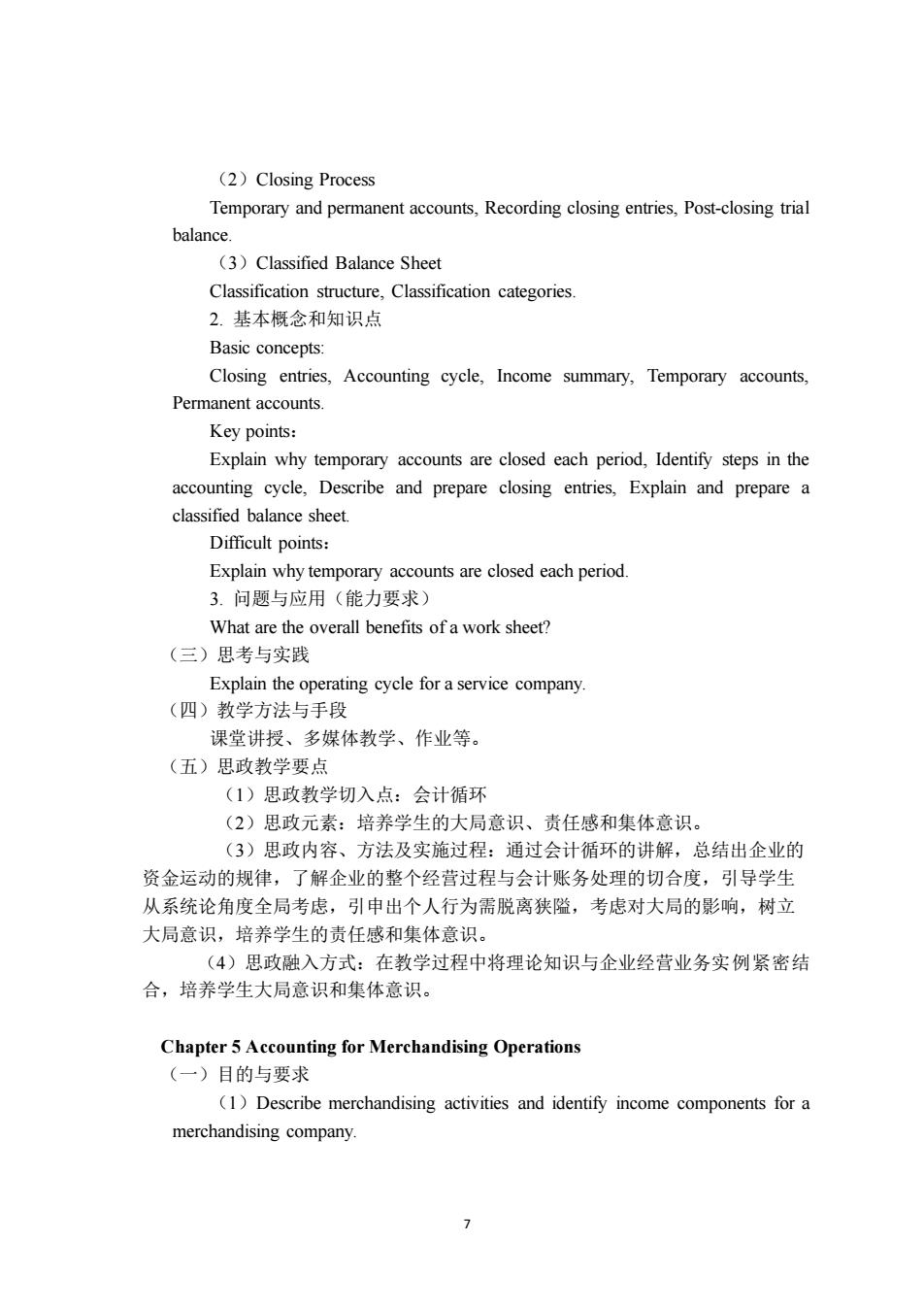
(2)Closing Process Temporary and permanent accounts,Recording closing entries,Post-closing trial balance. (3)Classified Balance Sheet Classification structure,Classification categories. 2.基本概念和知识点 Basic concepts: Closing entries.Accounting cycle.Income summary.Temporary accounts. Permanent accounts Key points: Explain why temporary accounts are closed each period,Identify steps in the accounting cycle,Describe and prepare closing entries,Explain and prepare a classified balance sheet Difficult points: Explain why temporary re dach period 3.问题与应用(能力要求) What are the overall benefits of a work sheet? (三)思考与实践 Explain the operating cycle for a service company (四)教学方法与手段 课堂讲授、多媒体教学、作业等。 (五)思政教学要点 (1)思政教学切入点:会计循环 (2)思政元素:培养学生的大局意识、责任感和集体意识。 (3)思政内容、方法及实施过程:通过会计循环的讲解,总结出企业的 资金运动的规律,了解企业的整个经营过程与会计账务处理的切合度,引导学生 从系统论角度全局考虑,引申出个人行为需脱离狭隘,考虑对大局的影响,树立 大局意识,培亲学生的责任感和集体意识。 (4)思政融入方式:在教学过程中将理论知识与企业经营业务实例紧密结 合,培养学生大局意识和集体意识。 Chapter 5 Accounting for Merchandising Operations (一)目的与要求 (1)Describe merchandising activities and identify income components for a merchandising company. 7
7 (2)Closing Process Temporary and permanent accounts, Recording closing entries, Post-closing trial balance. (3)Classified Balance Sheet Classification structure, Classification categories. 2. 基本概念和知识点 Basic concepts: Closing entries, Accounting cycle, Income summary, Temporary accounts, Permanent accounts. Key points: Explain why temporary accounts are closed each period, Identify steps in the accounting cycle, Describe and prepare closing entries, Explain and prepare a classified balance sheet. Difficult points: Explain why temporary accounts are closed each period. 3. 问题与应用(能力要求) What are the overall benefits of a work sheet? (三)思考与实践 Explain the operating cycle for a service company. (四)教学方法与手段 课堂讲授、多媒体教学、作业等。 (五)思政教学要点 (1)思政教学切入点:会计循环 (2)思政元素:培养学生的大局意识、责任感和集体意识。 (3)思政内容、方法及实施过程:通过会计循环的讲解,总结出企业的 资金运动的规律,了解企业的整个经营过程与会计账务处理的切合度,引导学生 从系统论角度全局考虑,引申出个人行为需脱离狭隘,考虑对大局的影响,树立 大局意识,培养学生的责任感和集体意识。 (4)思政融入方式:在教学过程中将理论知识与企业经营业务实例紧密结 合,培养学生大局意识和集体意识。 Chapter 5 Accounting for Merchandising Operations (一)目的与要求 (1)Describe merchandising activities and identify income components for a merchandising company
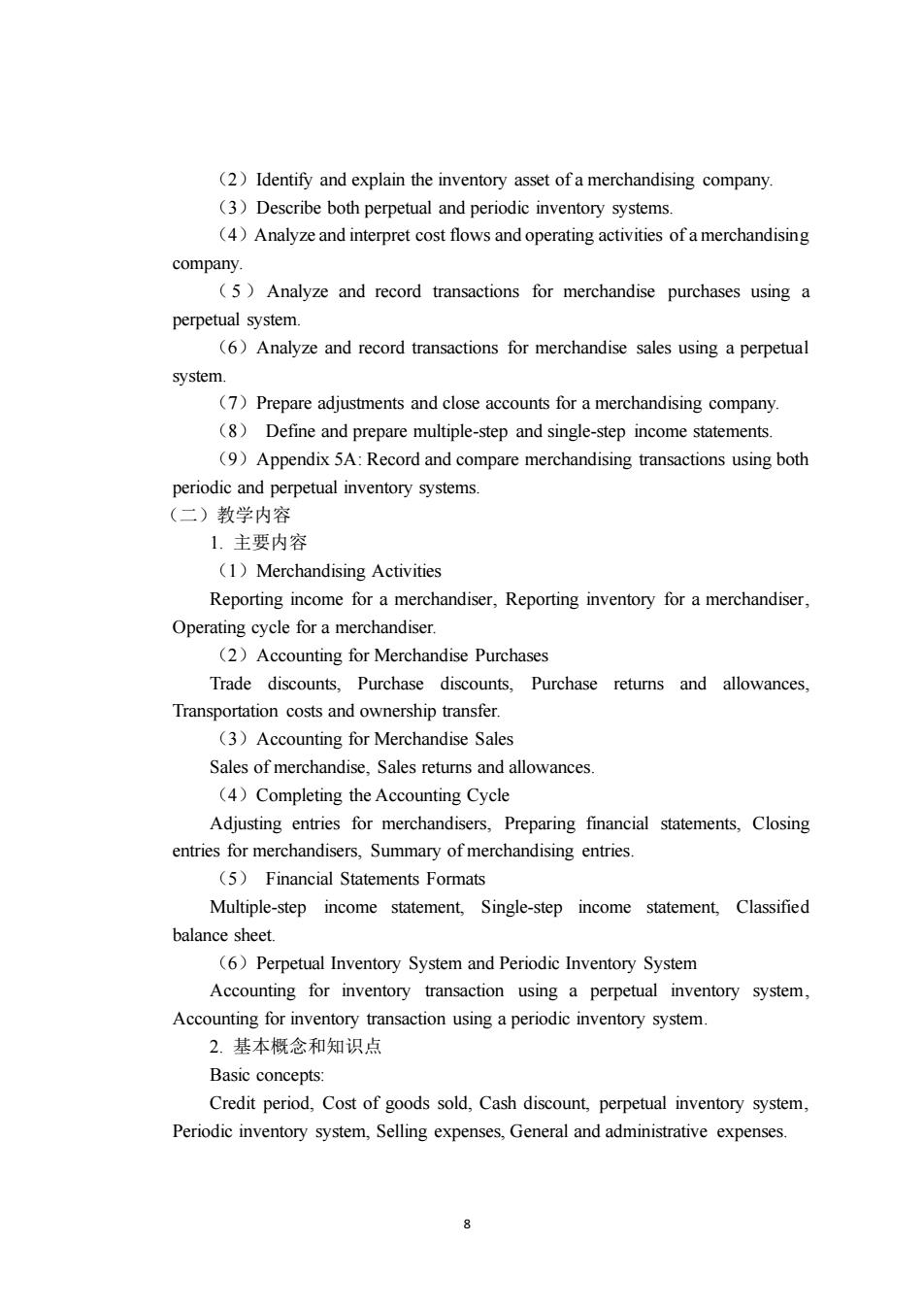
(2)Identify and explain the inventory asset of a merchandising company (3)Describe both perpetual and periodic inventory systems. (4)Analyze and interpret cost flows and operating activities ofa merchandising company. (5)Analyze and record transactions for merchandise purchases using a perpetual system. (6)Analyze and record transactions for merchandise sales using a perpetual system. (7)Prepare adjustments and close accounts for a merchandising company (8)Define and prepare multiple-step and single-step income statements. (9Appendix 5A:Record and compare merchandising transactions using both periodic and perpetual inventory systems. (二)教学内容 1.主要内容 (1)Merchandising Activities Reporting income for a merchandiser,Reporting inventory for a merchandiser, Operating cycle for a merchandiser. (2)Accounting for Merchandise Purchases Trade discounts,Purchase discounts,Purchase returns and allowances, Transportation costs and ownership transfer. (3)Accounting for Merchandise Sales Sales of merchandise.Sales returns and allowances. (4)Completing the Accounting Cycle Adjusting entries for merchandisers.Preparing financial statements,Closing entries for merchandisers,Summary of merchandising entries. (5)Financial Statements Formats Multiple-step income statement,Single-step income statement,Classified halance sheet (6)Perpetual Inventory System and Periodic Inventory System Accounting for inventory transaction using a perpetual inventory system. Accounting for inventory transaction using a periodic inventory system. 2.基本概念和知识点 Basic concepts Credit period.Cost of goods sold,Cash discount perpetual inventory system Periodic inventory system,Selling expenses,General and administrative expenses. 8
8 (2)Identify and explain the inventory asset of a merchandising company. (3)Describe both perpetual and periodic inventory systems. (4)Analyze and interpret cost flows and operating activities of a merchandising company. ( 5 ) Analyze and record transactions for merchandise purchases using a perpetual system. (6)Analyze and record transactions for merchandise sales using a perpetual system. (7)Prepare adjustments and close accounts for a merchandising company. (8) Define and prepare multiple-step and single-step income statements. (9)Appendix 5A: Record and compare merchandising transactions using both periodic and perpetual inventory systems. (二)教学内容 1. 主要内容 (1)Merchandising Activities Reporting income for a merchandiser, Reporting inventory for a merchandiser, Operating cycle for a merchandiser. (2)Accounting for Merchandise Purchases Trade discounts, Purchase discounts, Purchase returns and allowances, Transportation costs and ownership transfer. (3)Accounting for Merchandise Sales Sales of merchandise, Sales returns and allowances. (4)Completing the Accounting Cycle Adjusting entries for merchandisers, Preparing financial statements, Closing entries for merchandisers, Summary of merchandising entries. (5) Financial Statements Formats Multiple-step income statement, Single-step income statement, Classified balance sheet. (6)Perpetual Inventory System and Periodic Inventory System Accounting for inventory transaction using a perpetual inventory system, Accounting for inventory transaction using a periodic inventory system. 2. 基本概念和知识点 Basic concepts: Credit period, Cost of goods sold, Cash discount, perpetual inventory system, Periodic inventory system, Selling expenses, General and administrative expenses
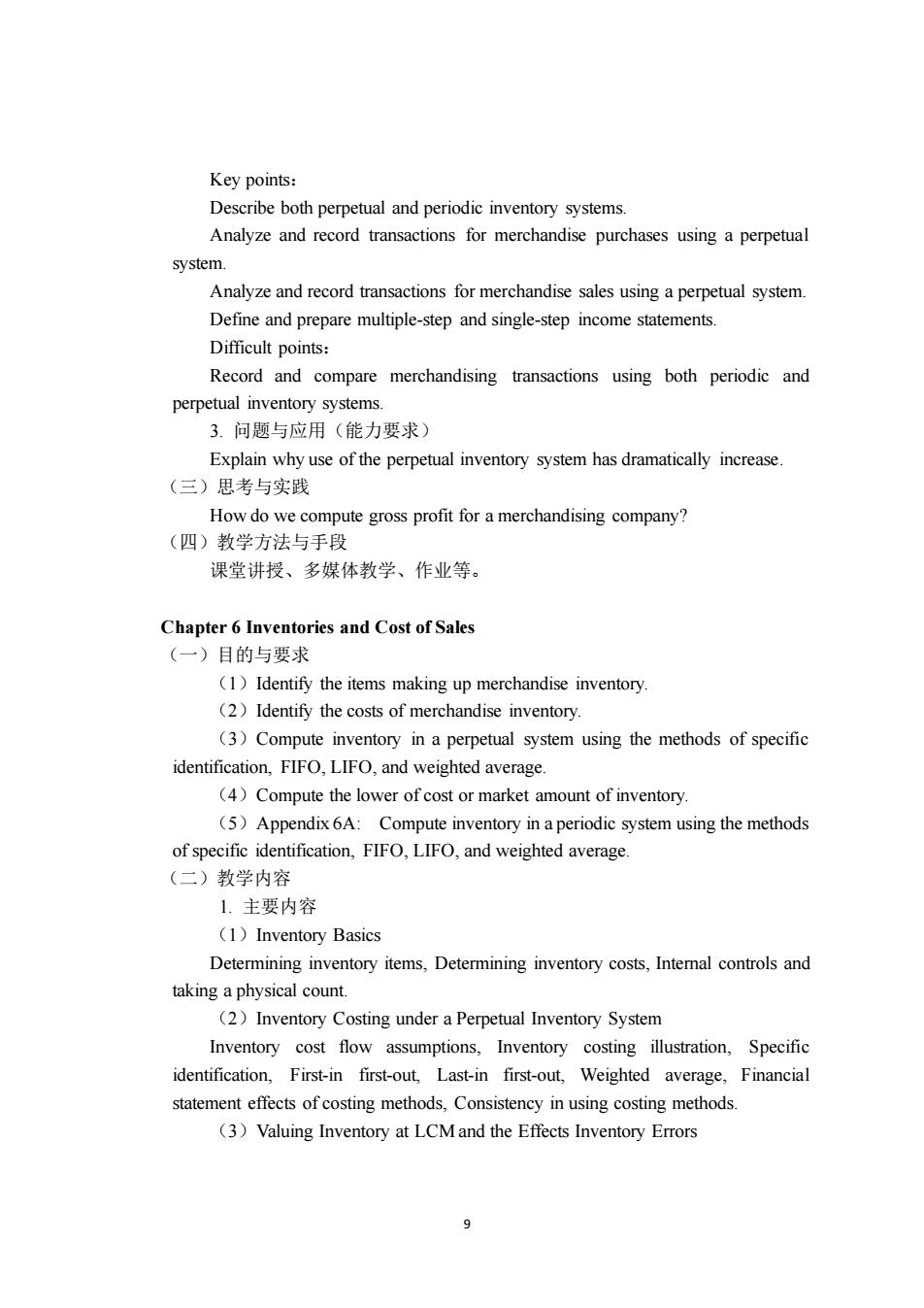
Key points: Describe both perpetual and periodic inventory systems. Analyze and record transactions for merchandise purchases using a perpetual system Analyze and record transactions for merchandise sales using a perpetual system Define and prepare multiple-step and single-step income statements. Difficult points: Record and compare merchandising transactions using both periodic and perpetual inventory systems 3.问题与应用(能力要求) Explain why use of the perpetual inventory system has dramatically increase (三)思考与实践 How do we compute gross profit foramerchandising company? (四)教学方法与手段 课堂讲授、多媒体教学、作业等。 Chapter6 Inventories and Cost of Sales (一)目的与要求 (1Identify the items making up merchandise inventory. (2)Identify the costs of merchandise inventory. (3)Compute inventory in a perpetual system using the methods of specific identification,FIFO,LIFO,and weighted average. (4)Compute the lower of cost or market amount of inventory. (5)Appendix 6A:Compute inventory in a periodic system using the methods of specific identification.FIFO.LIFO,and weighted average (二)教学内容 1.主要内容 (1)Inventory Basics Determining inventory items,Determining inventory costs,Intemal controls and taking a physical count. (2)Inventory Costing under a Perpetual Inventory System Inventory cost flow assumptions,Inventory costing illustration,Specific identification,First-in first-out,Last-in first-out,Weighted average,Financial statement effects of costing methods,Consistency in using costing methods. (3)Valuing Inventory at LCMand the Effects Inventory Errors
9 Key points: Describe both perpetual and periodic inventory systems. Analyze and record transactions for merchandise purchases using a perpetual system. Analyze and record transactions for merchandise sales using a perpetual system. Define and prepare multiple-step and single-step income statements. Difficult points: Record and compare merchandising transactions using both periodic and perpetual inventory systems. 3. 问题与应用(能力要求) Explain why use of the perpetual inventory system has dramatically increase. (三)思考与实践 How do we compute gross profit for a merchandising company? (四)教学方法与手段 课堂讲授、多媒体教学、作业等。 Chapter 6 Inventories and Cost of Sales (一)目的与要求 (1)Identify the items making up merchandise inventory. (2)Identify the costs of merchandise inventory. (3)Compute inventory in a perpetual system using the methods of specific identification, FIFO, LIFO, and weighted average. (4)Compute the lower of cost or market amount of inventory. (5)Appendix 6A: Compute inventory in a periodic system using the methods of specific identification, FIFO, LIFO, and weighted average. (二)教学内容 1. 主要内容 (1)Inventory Basics Determining inventory items, Determining inventory costs, Internal controls and taking a physical count. (2)Inventory Costing under a Perpetual Inventory System Inventory cost flow assumptions, Inventory costing illustration, Specific identification, First-in first-out, Last-in first-out, Weighted average, Financial statement effects of costing methods, Consistency in using costing methods. (3)Valuing Inventory at LCM and the Effects Inventory Errors

Lower of cost or Market,Financial statement effects of inventory errors (4)Inventory Costing Under a Periodic Inventory System Specific identification,First-in first-out,Last-in first-out,Weighted average Financial statement effects of costing methods 2.基本概念和知识点 Basic concepts. FIFO,LIFO,Lower of cost or market(LCM),Net realizable value,Specific identification,Weighted average,Average cost. Key points: Compute inventory in a perpetual system using the methods of specific identification,FIFO,LIFO,and weighted average Compute the lower of cost or market amount of inventory. Difficult points: Analyze the effects of inventory methods for both financial and tax reporting. 3.问题与应用(能力要求) (1)Analyze the effects of inventory methods for both financial and tax reporting. (2Analyze the effects of inventory errors on current and future financial statements (三)思考与实践 (1)What accounting principle most guides the allocation of cost of goods available for sale between ending inventory and cost of goods sold? (2)Use LCM applied separately to the following individual items to compute ending inventory. Product Units Unit Recorded Cost Unit Market Cost A 20 $6 S5 40 9 10 12 15 (四)教学方法与手段 课堂讲授、多媒体教学、作业等。 Chapter 7 Accounting Information Systems (一)目的与要求 (1)Identify fundamental principles of accounting information systems (2)Identify components of accounting information systems (3)Explain the goals and uses of special journals. 1
10 Lower of cost or Market, Financial statement effects of inventory errors. (4)Inventory Costing Under a Periodic Inventory System Specific identification, First-in first-out, Last-in first-out, Weighted average, Financial statement effects of costing methods. 2. 基本概念和知识点 Basic concepts: FIFO, LIFO, Lower of cost or market(LCM), Net realizable value, Specific identification, Weighted average, Average cost. Key points: Compute inventory in a perpetual system using the methods of specific identification, FIFO, LIFO, and weighted average. Compute the lower of cost or market amount of inventory. Difficult points: Analyze the effects of inventory methods for both financial and tax reporting. 3. 问题与应用(能力要求) (1)Analyze the effects of inventory methods for both financial and tax reporting. (2)Analyze the effects of inventory errors on current and future financial statements. (三)思考与实践 (1)What accounting principle most guides the allocation of cost of goods available for sale between ending inventory and cost of goods sold? (2)Use LCM applied separately to the following individual items to compute ending inventory. Product Units Unit Recorded Cost Unit Market Cost A 20 $6 $5 B 40 9 8 C 10 12 15 (四)教学方法与手段 课堂讲授、多媒体教学、作业等。 Chapter 7 Accounting Information Systems (一)目的与要求 (1)Identify fundamental principles of accounting information systems. (2)Identify components of accounting information systems. (3)Explain the goals and uses of special journals